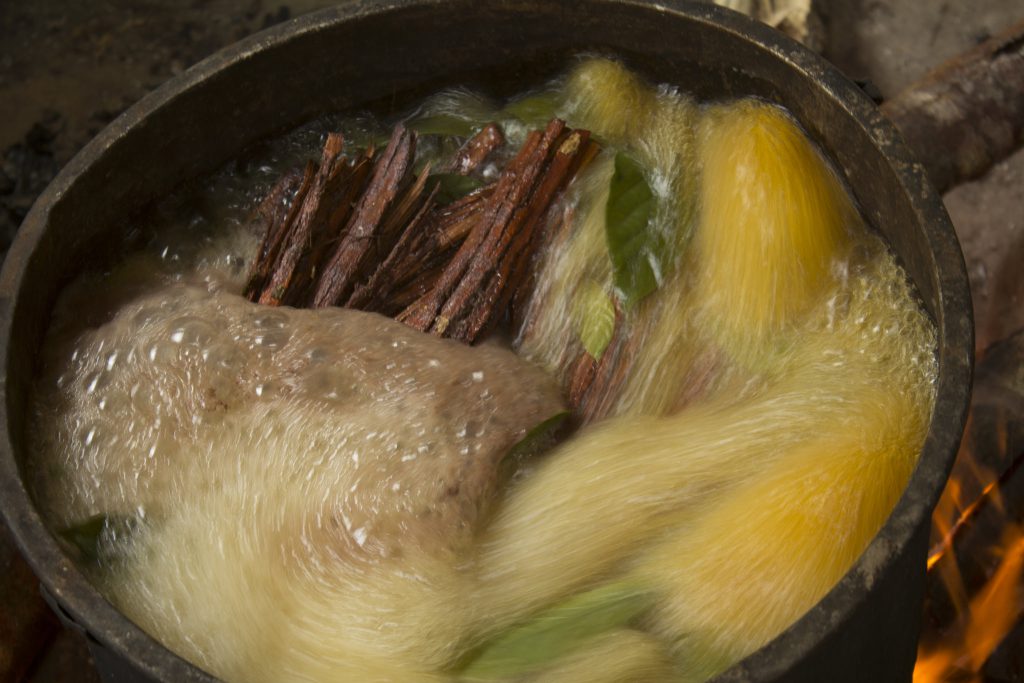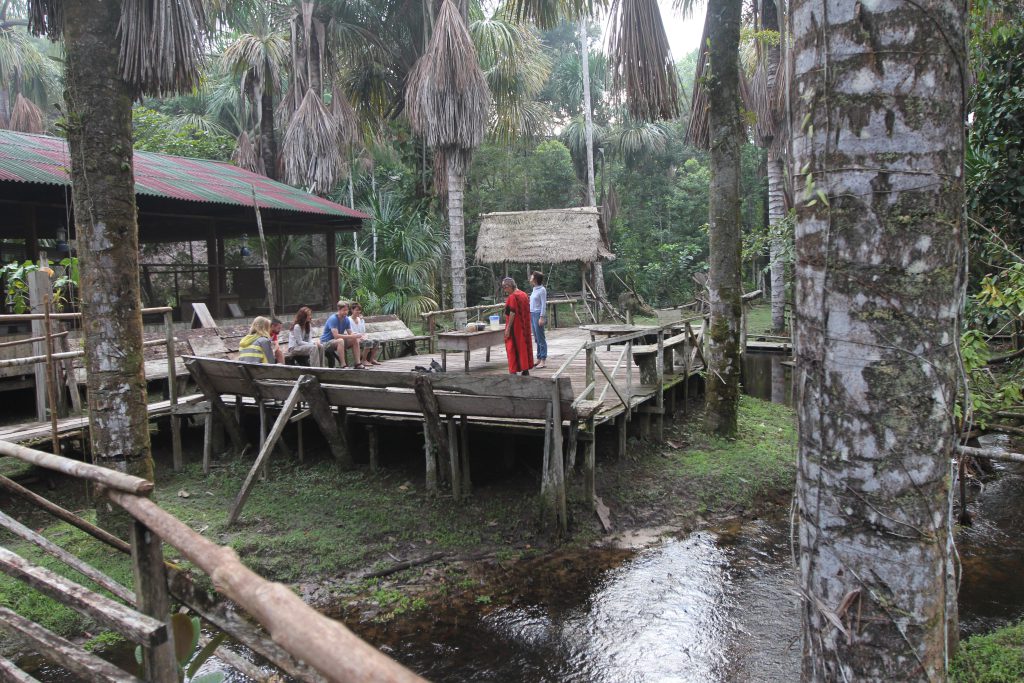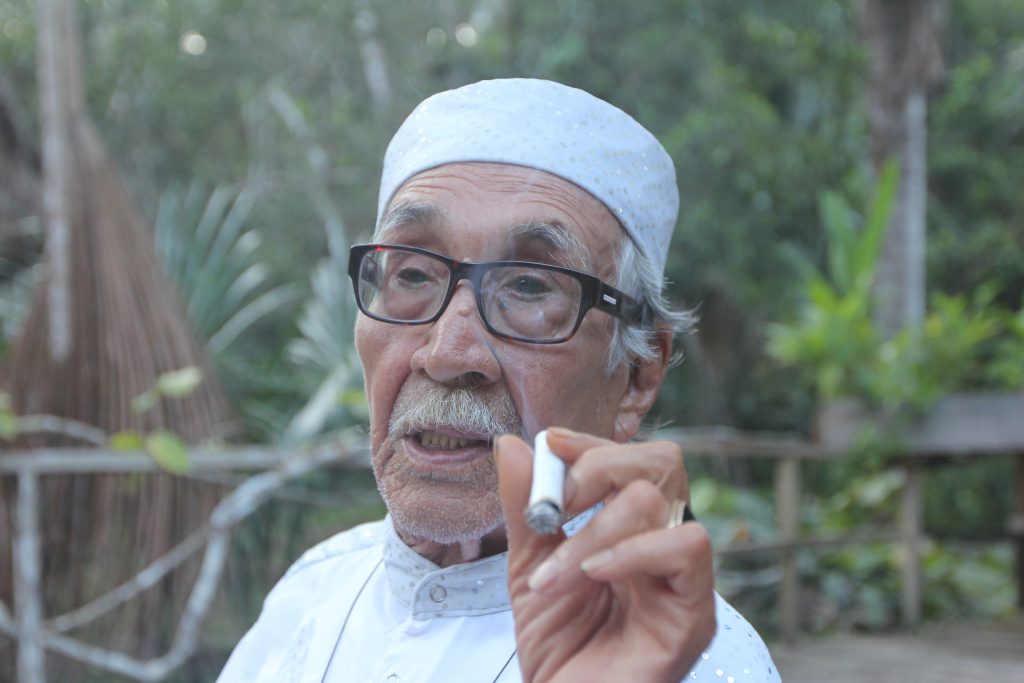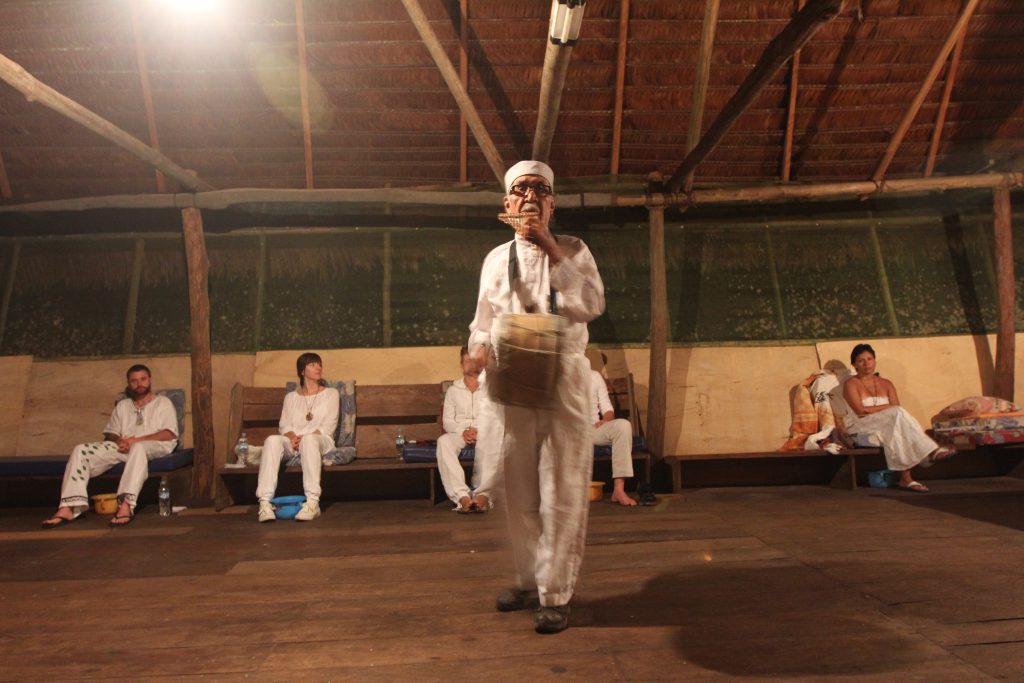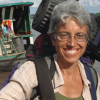The Perils and Privileges of an Amazonian Hallucinogen
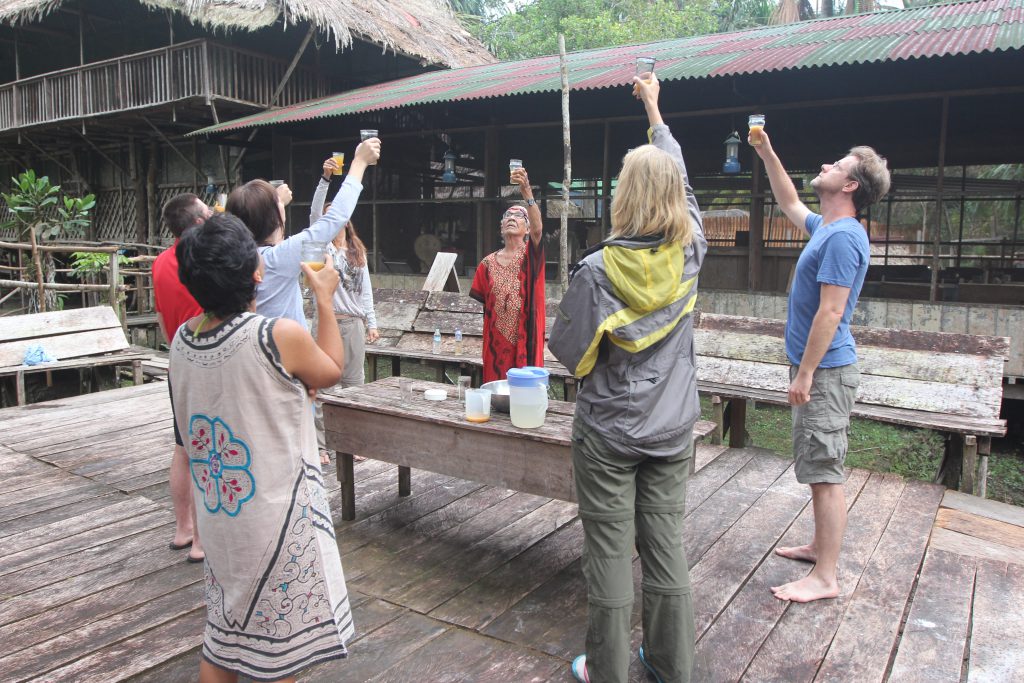
Jens Kossmagk gazed into the darkness and saw a black jaguar staring back at him. As he watched the wild cat, he slowly became the animal—he felt his cheekbones widen into feline features, his nails lengthen into savage claws.
Inside a peak-roofed wooden room in the heart of the Peruvian Amazon, a dozen white-clad figures sat nearly motionless, with their eyes closed. A drum sounded and a voice rose and fell in a chanted melody. Each time Kossmagk yawned with a low moan, his jaguar appeared as though conjured. The ceremony lasted several hours until at last, sometime before midnight on this July night in 2016, the images faded, the jaguar slipped back into the forest, and the figures in white stumbled to their beds. They would be up early the next morning to jot notes in their journals over a glass of strong ginger tea, take a dip in a chilly stream, and salute the sun in a brief ritual with a New Age feel.
These were a handful of the thousands of people who travel to the Amazon each year to sample ayahuasca, a hallucinogenic brew made from Amazonian plants. Some seek physical or psychological healing, and others wish for a spiritual awakening. Some say the experience gives them personal insight, helps to heal past traumas, or provides a way to deal with addiction. Others are driven by curiosity and a thirst for adventure. Once a pastime for young backpackers trekking around the region on the cheap, ayahuasca tourism has recently become popular with upscale travelers. Most of them pay more than US$100 a day for regimes advertised as traditional healing methods through plant-based diets, tobacco purges, and, of course, ayahuasca ceremonies.
The boom has not only met the demands of tourists seeking alternative therapies; it has also reawakened interest in traditional plant-based medicine among Indigenous peoples and created jobs in a semirural Amazonian region where employment is scarce. But the trend is also controversial. Critics decry the for-profit use of traditional medicine and practices, the tailoring of what they see as an ancient Amazonian ritual to accommodate modern tourists’ expectations, the preponderance of lodges in the hands of foreign-born owners, and the lax regulations surrounding ayahuasca’s potentially dangerous use.
“The phenomenon is complex,” says Brazilian anthropologist Beatriz Caiuby Labate, a visiting professor at the Center for Research and Post Graduate Studies in Social Anthropology (CIESAS) in Guadalajara, Mexico, who has written and edited books on the subject. Attitudes toward ayahuasca tourism span a continuum between two extremes, she says: “One pole is the messianic salvation and healing of the Amazon and humanity, and the other is that it is either a dangerous hallucinogen or a perverse cultural appropriation of Indigenous traditions.”
The potion commonly known as ayahuasca is made from two plants. The hallucinogen in the brew—N,N-dimethyltryptamine, or DMT—comes from a bush, Psychotria viridis, known as chacruna. DMT occurs naturally in the human body, and some researchers wonder if it could play a role in dreaming. When ingested, however, DMT is typically inactivated by an enzyme in the human gut. The Banisteriopsis caapi vine—the plant generally known as ayahuasca—contains an alkaloid that suppresses that enzyme. So when the ayahuasca vine and the chacruna leaf are brewed together and consumed as a tea, the DMT hits the brain and the drinker may see visions: vivid, multicolor, dream-like scenes such as Kossmagk’s jaguar.
DMT is treated as a controlled substance in many countries, including Germany, Australia, Brazil, and the United States. In Brazil, several organizations claim ayahuasca use as a religious sacrament and have received designation as churches, which allows them to use it legally. In Peru, the government does not regulate ayahuasca because of its traditional use.
When anthropologist Evgenia Fotiou of Kent State University in Kent, Ohio, began her research into ayahuasca tourism around the Amazonian port city of Iquitos, Peru, 15 years ago, she could count on her fingers the number of lodges catering to tourists. “It was hard to find people to interview,” she says. “Interest was just starting. People were still trying things out.”
Today, ayahuasca retreats are offered in Peru and Brazil, as well as in Ecuador, Colombia, and Bolivia, with the trend’s epicenter in Iquitos, a city of more than half a million people in the Amazonian lowlands. The city, a vibrant mix of modern commerce, tourism, and the ragged remnants of rubber boom glory, is surrounded by the country’s largest expanse of tropical forest, accessible only by air or river. Local tourism operators estimate that between 50 and 100 lodges in the area cater to tourists seeking ayahuasca. Restaurants in Iquitos’ tourist zone even offer special menus for people who are avoiding certain foods—such as cured meats, spicy fare, fermented foods, and dairy products—in preparation for an ayahuasca ritual.
The rustic retreat chosen by Kossmagk, a 43-year-old computer specialist from Berlin, Germany, is near the small Amazon River town of Tamshiyacu, about an hour and a half by boat from Iquitos. Kossmagk came, he says, in search of an experience that would help him connect his head and his heart. A fellow guest, who identified herself only as Eva, says she booked her trip while hospitalized for a psychological breakdown. She hoped the 11-day retreat would help her overcome anxiety that traditional therapy had not eased. Ulrike Bellstedt, 32, who practices natural medicine in Stuttgart, Germany, was participating in her third retreat at this lodge in less than a year. She planned to spend several weeks studying traditional healing and learning the healing songs, called ikaros, so she could eventually incorporate the practices into her work at home.
The lodge is owned and run by Agustín Rivas Vázquez, one of the region’s best-known ayahuasqueros, plant medicine specialists who use ayahuasca, although Rivas works with other plants as well. Like many ayahuasca healers in Peru, Rivas is mestizo, of mixed European and Indigenous descent. A small, wiry man with a bushy white mustache and horn-rimmed glasses, his vitality belies his age—82 according to his identity documents, although he says he is really 91. As a young man, Rivas was a well-known wood sculptor. But after an accident in 1976 left him with no sensation in his right hand, he started making a living from practicing plant medicine, which he had learned from Indigenous shamans. Some people who had met him through his art sought him out for healing rituals, and he traveled to Europe and the United States to practice. Eventually he opened his Peruvian retreat in the forest outside of his hometown, where he also tends cassava and banana plants like any Amazonian farmer.
Rivas works with a variety of plants as well as smoke from native tobacco. He claims to be able to cure psychological and spiritual ills, as well as physical ailments, including cancer, although there are some problems, such as tuberculosis, that he says he cannot treat. (Scientific studies have hinted that there might be some basis for claims that ayahuasca helps fight cancer, though there hasn’t been enough research to show if it actually works.) He warns against unrealistic expectations and charlatans who claim to perform miracle cures. “Someone is missing an arm and thinks the shaman will give them an arm, or they’re blind and think the shaman can restore their sight,” he says.
Rivas says he has received as many as 50 to 60 visitors a month, though the number is now declining because of competition from other lodges. Other people in Tamshiyacu—including his life partner, his son, and several ayahuasqueros who apprenticed with him—also offer ayahuasca retreats. And more expensive, market-savvy lodges closer to Iquitos offer ayahuasca ceremonies along with adventure tourism, yoga, fitness regimes, or other activities.
The industry’s boom has come with a dark side. Some women have reported that they were sexually assaulted by shamans, which has led more lodges to offer ceremonies with female healers. There have been at least nine deaths at ayahuasca lodges in the past few years, according to news reports and a staffer in the Ministry of Culture office in Iquitos, although it is not clear whether any were directly linked to ingesting ayahuasca. Some were related to other plant-based brews. Two travelers died at lodges near Iquitos and Puerto Maldonado, Peru, in recent years, reportedly from drinking a purgative tea made of native tobacco, for example. And a Canadian man stabbed a British man under confusing circumstances at an ayahuasca lodge near Iquitos in December 2015.
Tourism officials in Iquitos shy away from the topic of deaths. Some tour operators brush off the hazards, saying the victims had underlying medical conditions or had combined ayahuasca with marijuana, cocaine, or antidepressant or antipsychotic prescription medications. Fotiou thinks that’s the wrong approach. “We need to figure out why these deaths happened,” she says. “If we want to prevent this from happening, minimizing it doesn’t help.”
Efforts to regulate the industry have been rocky so far. A fledgling international nonprofit organization called the Ethnobotanical Stewardship Council launched in 2013 in part to address these safety concerns, along with worries about the potential over-harvesting of wild ayahuasca vines. But the council disbanded two years later, after a group of anthropologists raised concerns, arguing particularly that the council’s proposal for certification of ayahuasca lodges would have amounted to outsiders regulating Indigenous people’s traditional practices.
Read more from the archives: “The Cosmic Serpent.”
Early this year, several dozen lodge operators from around Iquitos met to discuss forming the Ayahuasca Safety Association, which aims to promote safety, health, and labor standards. The nascent effort was spurred in part by international pressure on Peru after some higher-profile deaths. The association recently gained legal status as a Peruvian nonprofit organization and hopes to attract members from throughout the country, says Sascha Thier, president of the group, who worked for more than six years at the Temple of the Way of Light, one of the largest lodges, which is outside of Iquitos.
“The main goal of the association is to avoid any more tragedies,” Thier says. “Every single death that happened was preventable.”
The problem, Thier says, is that “everybody can just come, open a center, and start pouring ayahuasca and have no idea what they’re doing. … and nobody asks you about medical conditions, medications you’re taking, or anything like this. It’s just a disaster waiting to happen.” The association has drafted “ethical, safety, and good practice guidelines” that cover transparency, the prevention of sexual abuse, and the financial exploitation of participants. They also call for safety and emergency procedures and the disclosure of the ingredients used in the potions. The guidelines would require screening participants for safety and health risks related to their “pharmacological history and physical and mental health history.” Lodges that sign on would also pledge to provide quality services and comply with Peruvian laws, including paying taxes and employee benefits such as health care and retirement.
Besides potential dangers, another touchy issue is whether locals are getting their fair share from the tourism and whether tourist retreats distort the nature of a traditional practice.
Traditionally, Indigenous peoples used ayahuasca in various ways, including in ceremonies where participants would recount their myths, says Fotiou. “It would be a ritual that would reaffirm the community and their stories of origin.” The tourist boom has boosted the popular image that ayahuasca has been used ritually by Indigenous peoples throughout the Amazon for thousands of years. But that may not be true.
“It’s easy to [assume] that these things have been done forever by remote Indigenous cultures,” says Labate, the Brazilian anthropologist. “Ayahuasca’s popularity, trendiness, and spread around the world are entrenched in this idea of deep Indigenous wisdom.” But some anthropologists think the use of the hallucinogenic potion may have been fairly limited before the upheavals caused by the arrival of Spanish missionaries in the 17th and 18th centuries, and the onset of the rubber boom in the 19th century. Its use may have only become widespread in those centuries, as contact between Indigenous groups increased.
As its use has spread around the world, ayahuasca rituals have taken on New Age overtones and merged with Eastern practices. The practice, just like the rest of Indigenous culture, is “dynamic and in transformation,” says Labate.
Although the question of whether outsiders are appropriating and changing a traditional practice for profit inevitably arises, Fotiou says the use of ayahuasca by foreign tourists is just the most recent form of a long history of sharing between cultures. “The exchange shouldn’t be seen as problematic,” says Fotiou, since people have been exchanging things like plant knowledge “forever.” More problematic, she says, is the power difference between the visitors and the local people. “The visitors are more privileged, in every sense.” Foreign tourists have the means to travel to exotic destinations for leisure; local shamans or employees at lodges may not even earn minimum wage.
Most current lodge operators are foreign-born owners who hire local shamans to conduct ceremonies, Thier says. There’s a reason for that: “You have to speak English. You have to know how to cater to foreigners,” says Fotiou. “It has become more of a hospitality industry.” She has seen lodges come and go; often those that fail were started by local people who may have known plant medicine, but they had no tourism experience. But the foreign investment also leads some to question whether this form of tourism benefits local communities.
One positive outcome of the ayahuasca tourism boom, notes Fotiou, is that the industry is spurring renewed interest in traditional plant medicine among Indigenous young people. “Until two or three decades ago, I would say that shamanism was dying, because it is a hard path. It takes a lot of sacrifice to become a shaman,” she says. Now, however, the possibility of employment in the tourism industry makes that sacrifice more attractive.
The boom might also be responsible for an increased exchange between Indigenous knowledge and Western science and medicine, as researchers investigate possible uses of ayahuasca for treating problems such as addiction and depression. Similar studies are being done with other psychedelic substances, such as psilocybin, the active compound in magic mushrooms.
“Psychedelics allow us to look at the human mind in a way that we’ve never had the chance to look at it,” says Draulio de Araujo, a professor of brain imaging at Brazil’s Federal University of Rio Grande do Norte. His research indicates that ayahuasca may ease depression and that the effects can be similar to those of mindfulness meditation.
In the end, foreigners who venture into the world where tourism and cultural traditions mix can come away with a deeper understanding of themselves and of other people, says Bellstedt, the German naturopath who sat in the circle with Kossmagk and his jaguar as the rhythmic drumming and chanting wove through their visions.
“It changed my life,” Bellstedt says of her first visit, which was in November 2015. “I can see the world with other eyes. I see that the problems we have aren’t real—they’re all in our mind.” She hopes to lead others to that same realization. “I’m coming here to learn and to understand life and to help people,” she says. “I often ask myself what I’m doing here, but I know it’s right.”
This article was republished in The Atlantic.

































